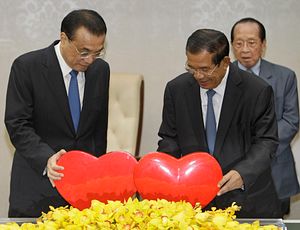Over the weekend, China and Cambodia kicked off this year’s iteration of a new military exercise. The engagement was just another demonstration of the significance of the defense ties between the two sides and Cambodia’s greater drift towards China as the ruling party under Prime Minister Hun Sen looks to further consolidate its power in upcoming elections later this year.
As I have noted repeatedly in these pages, Cambodia has a long and strong defense relationship with China, with Beijing being the largest donor of military aid and asking few of the questions that some Western countries, including the United States and Australia, have over the country’s worsening rights record (See: “The Truth About US-China Competition in Cambodia”). Over the past few years in particular, China and Cambodia have been expanding ties even further in this realm, including with new exercises and engagements, even as Phnom Penh has downgraded military ties with Washington and Canberra.
One of these has been Exercise Golden Dragon, which, when it took place in December 2016, was billed the first operation of its kind. At the time, it featured roughly 500 soldiers from both sides and focused on areas such as flood relief, emergency road repairs and construction, and natural disaster medical treatment. Reports had begun surfacing since January that the next iteration of the exercise would be held this year in March, during the year when both sides are commemorating the 60th anniversary of the establishment of their relationship just months before general elections in July which the Cambodian People Party (CPP) has been focused on winning.
Sure enough, on March 17, the two countries kicked off Golden Dragon 2018, with Major General Zhang Jian, the commander of the Chinese People’s Liberation Army (PLA) Southern Theater Command, and Pol Saroeun, the commander-in-chief of the Royal Cambodian Armed Forces (RCAF), officially presiding over the launch of the drills. Local media reports indicated that this iteration of the exercise involved 280 Cambodian soldiers and 216 Chinese soldiers, which constitutes a greater number of Chinese personnel than figures earlier touted by Cambodian officials. The exercise is also expected to last until March 30, which is longer than the 2016 iteration.
The exercise was publicized as being centered on counterterrorism and humanitarian assistance and disaster relief. Substantively, troops were expected to be involved in several activities during the drills, including the firing of missiles, shooting from helicopters, defusing explosive devices, and repairing roads. China is also expected to donate military equipment to Cambodia in a further demonstration of Beijing’s role in bolstering the Hun Sen government (See: “What Does Hun Sen’s New Military Aid Boost Really Mean?”).
































